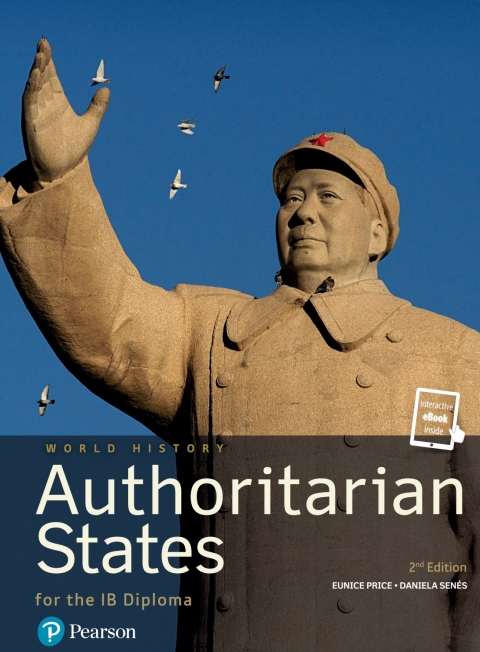Description
Efnisyfirlit
- Contents
- Introduction
- Topics and exam tips
- Chapter 1: Fidel Castro and Cuba
- 1.1: The emergence of an authoritarian state
- Conditions in which Castro emerged – Cuba before the revolution
- The Cuban Revolution and the emergence of Fidel Castro
- To what extent did Batista contribute to the success of the revolution and the emergence of Castro?
- The triumph of the revolution
- 1.2: Consolidation and maintenance of power
- The consolidation of power, 1959–62
- Use of legal methods – the reforms of 1959–62
- The impact of foreign policy on Castro’s consolidation of power, 1959–62
- The role of ideology
- 1.3: Aims and results of Castro’s policies
- Aims and results of economic policies
- The aims and impact of social policies
- The aims and impact of cultural policies
- Propaganda
- Aims and impact of political policies and treatment of opposition
- The impact of foreign policy on Castro’s maintenance of power
- Castro’s foreign policy after the collapse of the Soviet Union
- The extent to which Castro achieved authoritarian control
- Chapter 2: Josef Stalin and the Soviet Union
- 2.1: The emergence of an authoritarian state
- Stalin’s background and role in the emergence of an authoritarian state in Russia
- 2.2: Aims and results of Stalin’s policies
- Stalin’s economic policies
- Peasants to proletariat
- The First, Second, and Third Five-Year Plans
- How did Stalin carry out the Five-Year Plans?
- Stalin’s social and cultural policies
- 2.3: Consolidation and maintenance of power
- What methods did Stalin use to maintain power?
- The extent to which Stalin achieved authoritarian control
- An overview of Stalin’s domestic policy
- Stalin’s foreign policy up to 1941
- Stalin’s foreign policy from 1941
- Reasons for Stalin’s victory
- An overview of Stalin’s foreign policy in his maintenance of power
- 2.4: Stalin and the Soviet Union after 1945
- Economic recovery after 1945
- Domestic policies after 1945 – aims and results
- Terror and propaganda after 1945
- Stalin’s role as a world leader
- The death of Stalin
- Chapter 3: Mao Zedong and China
- 3.1: The emergence of an authoritarian state
- Mao’s background and role in the establishment of an authoritarian state in China
- China and World War I
- Mao and the emergence of the CPC
- The Nanjing Decade, 1928–37
- The emergence of Mao as leader of the CPC
- The Second United Front, 1936–45
- The GMD at the end of World War II
- The Second Chinese Civil War, 1946–49
- 3.2: Consolidation and maintenance of power
- Domestic policies and their impact, 1949–76
- The First Five-Year Plan, 1953–57
- How did Mao deal with opposition?
- The Second Five-Year Plan – the Great Leap Forward, 1958–63
- Mao’s foreign policy
- Towards the Cultural Revolution
- The purpose of the Cultural Revolution
- An unexpected shift in China’s foreign policy
- The death of Mao
- 3.3: Assessing Mao as an authoritarian leader
- What did Mao achieve?
- Historians’ assessments of Mao
- Chapter 4: Benito Mussolini and Italy
- 4.1: The emergence of an authoritarian state
- Historical background of Italy, 1861–1914
- The emergence of Benito Mussolini
- The role of Mussolini’s fascist ideology
- Use of coercion and the March on Rome, October 1922
- 4.2: Aims and results of Mussolini’s domestic policies
- Political policies
- Relations with the Catholic Church– the Lateran Pact
- Economic policies
- Propaganda
- The impact of policies on minorities and women
- 4.3: The use of foreign policy in Mussolini’s consolidation and maintenance of power
- To what extent did Mussolini use Italy’s foreign policy to consolidate his power?
- Foreign policy between 1922 and 1934
- Foreign policy, 1935–39
- 4.4: Assessing Benito Mussolini as an authoritarian leader
- Chapter 5: Gamal Abdel Nasser and Egypt
- 5.1: The emergence of an authoritarian state
- A brief overview of Egypt up to 1945
- Egypt and World War II – a state of limited independence
- Nasser’s early years
- The Free Officers’ Movement
- Post-war Egypt
- The coup of 1952
- Domestic policies up to 1955
- Methods used by Nasser to become the leader of Egypt
- An overview of Nasser’s rise to power
- 5.2: Consolidation and maintenance of power
- The impact of foreign policy on the maintenance of power
- The Suez Crisis, 1956
- 5.3: Aims and results of Nasser’s policies
- Domestic policies – Nasser after Suez
- The UAR, 1958–61 – ‘three-and-a-half years of troubles’
- Post-UAR – from the National Union to the Arab Socialist Union
- Economic problems and solutions
- Foreign policy – Entanglement and defeat
- The results of Nasser’s social and cultural policies
- Nasser and the treatment of opposition
- The personality cult of Nasser
- Conclusion – Did Nasser achieve his aims?
- Chapter 6: Comparing and contrasting authoritarian states
- Theory of Knowledge
- Further Reading
- Books and articles
- Websites
- Glossary
- Index
- Back Cover






Reviews
There are no reviews yet.